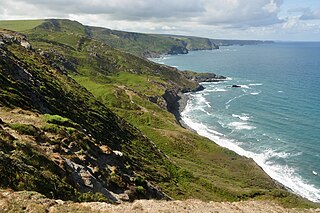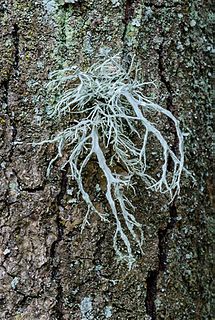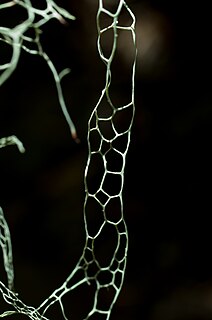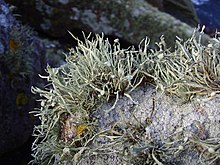
Portencross is a hamlet near Farland Head in North Ayrshire, Scotland. Situated about three kilometres west of Seamill and about two kilometres south of Hunterston B nuclear power station, it is noted for Portencross Castle.

Ramalina fraxinea, the cartilage lichen, is a fruticose lichen with erect or pendulous thalli and branches that are flattened. Colour varies from pale green though yellow-grey to white-grey; apothecia are frequent and soralia may also be present.

Ramalina is a genus of greenish fruticose lichens that grow in the form of flattened, strap-like branches. Members of the genus are commonly called strap lichens or cartilage lichens. Apothecia are lecanorine.

Edible lichens are lichens that have a cultural history of use as a food. Although almost all lichen are edible, not all have a cultural history of usage as an edible lichen.

Boscastle to Widemouth is a coastal Site of Special Scientific Interest (SSSI) in Cornwall, England, noted for its biological and geological characteristics. The Dizzard dwarf oak woodland is unique and of international importance for its lichen communities, with 131 species recorded.

Peninnis Head is the southernmost point of St Mary's, Isles of Scilly. The headland is within the Isles of Scilly Area of Outstanding Natural Beauty and part of the Heritage Coast. It is also a Geological Conservation Review site for its Quaternary geomorphology and was first designated a Site of Special Scientific Interest (SSSI) in 1971 for both its biological and geological interests. On the tip of the headland is a squat lighthouse built in 1911 by Trinity House as a replacement for the 17th century lighthouse on St Agnes.

Ramalina farinacea is an epiphytic bushy shaped (fruticose) lichen common to areas with Mediterranean, subtropical, or temperate climates. It is in the genus Ramalina of the family Ramalinaceae. The coexistence of two different species of the Trebouxia genus of green algae at the same time were found to be in each specimen collected in widely distributed populations. The algae thrive in different temperature and light environments. It is thought this demonstrates an ability of the lichen with two simultaneous green algae partners to proliferate in a wider range of habitats and geographic areas.

Ramalina menziesii, the lace lichen or fishnet, is a pale yellowish-green to grayish-green foliose lichen. It grows up to a meter long, hanging from bark and twigs in a distinctive net-like or lace-like pattern that is unlike any other lichen in North America. It becomes a deeper green when wet. Apothecia are lecanorine. it is an important food source for deer in the Coast Range of California, and a source of nest material for birds. It is highly variable in its growth form, with branches sometimes so slender as to appear like strands, sometimes tiny, and sometimes large with broadly flattened branches.

Niebla homalea is a species of fruticose lichen that grows on rocks in foggy areas along the Pacific Coast of North America, from Mendocino County, California south to Bahía de San Quintín on the main peninsula of Baja California, with an isolated occurrence further south on vertical rock faces above Punta Camachos, and other occurrences in the Channel Islands and on Guadalupe Island. The epithet homalea, given by Acharius, suggests it was in regard to the branches appearing flattened.
Vermilacinia ceruchis is a fruticose lichen found on sand and rock in coastal fog areas of Peru and Chile.
Vermilacinia procera is a fruticose lichen of local occurrences on rocks near the sea along the Pacific Coast from San Francisco California to the Channel Islands, and to Punta Escarpada in Baja California. The species is also reported to occur further south to the Vizcaíno Peninsula and on Cedros Island, but these reports are controversial in view of different interpretations of the species that include V. pumila and V. paleoderma that were not recognized at the time V. procera was described ; for example, a specimen collected on Guadalupe Island by Weber and MCoy (L-3605, COLO that was cited by Phillip Rundel and Peter Bowler in 1994 as belonging to Niebla procera, whereas in a revision of the genus by Richard Spjut in 1996, it was cited as belonging to Vermilacinia paleoderma. Both authorities generally agree to some extent on the description of the species and its geographical range within the California Floristic Province.
Vermilacinia cephalota is a fruticose lichen usually found on trees, shrubs and wooden fences in the fog regions along the Pacific Coast of North America from southeastern Alaska to the Vizcaíno Peninsula of Baja California.
Vermilacinia cerebra is a fruticose lichen that grows on trees and shrubs in the fog regions along the Pacific Coast of North America from the Channel Islands and mainland California near Los Angeles to southern Baja California, also occurring in South America in the Antofagasta Province of northern Chile. The epithet is in reference to the apical swollen lobes that resemble the cerebrum of the brain.
Vermilacinia tigrina is a fruticose lichen that grows on branches of shrubs and on earth among cactus and shrubs in the fog regions along the Pacific Coast of North America and South America; in North America found in the Channel Islands and near San Diego, California, and in central and southern Baja California; in South America from Peru to Chile. The epithet is in reference to the irregular black spots or bands on the thallus branches.
Niebla marinii is a fruticose lichen that grows on lava along the Pacific Coast of Baja California from near San Fernando Canyon south to Morro Santo Domingo. The epithet, marinii, is in honor of a field assistant, Richard Marin, who accompanied the author on lichen-collecting expeditions to Baja California during 1985–1996, while he also assisted in the gathering of samples of flowering plants for cancer research.

Isolichenan, also known as isolichenin, is a cold-water-soluble α-glucan occurring in certain species of lichens. This lichen product was first isolated as a component of an extract of Iceland moss in 1813, along with lichenin. After further analysis and characterization of the individual components of the extract, isolichenan was named in 1881. It is the first α-glucan to be described from lichens. The presence of isolichenan in the cell walls is a defining characteristic in several genera of the lichen family Parmeliaceae. Although most prevalent in that family, it has also been isolated from members of the families Ramalinaceae, Stereocaulaceae, Roccellaceae, and Cladoniaceae. Experimental studies have shown that isolichenan is produced only when the two lichen components – fungus and alga – are growing together, not when grown separately. The biological function of isolichenan in the lichen thallus is unknown.
Ramalina erosa is a species of fruticose lichen in the family Ramalinaceae. It was described as a new species by Hildur Krog in 1990. The type specimen was collected from Pico do Facho on Porto Santo Island (Portugal), where it was found growing on acidic rock at an elevation of 500 m (1,600 ft).

Salazinic acid is a depsidone with a lactone ring. It is found in some lichens, and is especially prevalent in Parmotrema and Bulbothrix, where its presence or absence is often used to help classify species in those genera.

Ramalina americana, commonly known as the sinewed ramalina, is a pale green fruticose lichen that is found across the Northern US Midwest, extending into Southern Canada and the Eastern Seaboard. It is characterized morphologically by the presence of pseudocyphellae, straight spores, and its unique chemical diversity.











